I want to know the basic/fundamental difference between AM and FM radio. Why nowadays FM radio has replaced AM and has become more popular?
-
5Phase modulation is actually more popular then frequency modulation, but you are probably thinking of listening to music. I will bet money your phone uses a form of PSK. – Kortuk Sep 03 '12 at 22:27
-
@Kortuk: As [also does](http://en.wikipedia.org/wiki/Phase-shift_keying#Applications) WLAN (802.11). – boardbite Sep 04 '12 at 09:26
-
4@boardbite - PM is often combined with AM as QAM (Quadrature Amplitude Modulation) to get 6 or even 8 bits per baud, which in pure PM would be nearly impossible. – stevenvh Sep 04 '12 at 09:40
9 Answers
Short answer: FM is far less susceptible to disturbance of the signal.
This is an AM modulated signal. The contours are the baseband signal which we recover by demodulation. Notice that there's a spike in the signal, which may be caused by a thunderstorm for instance.
This is the demodulated signal. The demodulator doesn't "know" that the spike isn't actual part of the signal, so it can't remove it, and the listener will hear a tick in the symphony she's listening to.
FM has a constant amplitude, and the demodulator won't be fooled by spikes in amplitude since it will detect variations in frequency.
This is an FM signal. The baseband signal determines the change in frequency of the carrier. Notice that the spike doesn't change the frequency, so it won't be audible after demodulation.
- 13,481
- 4
- 40
- 80
- 145,145
- 21
- 455
- 667
-
Beautiful, clear explanation. Is there a particular limiting factor of FM that prevented it from being used first historically? Granted one has to come before the other in terms of scientific timeline, but why wasn't frequency modulation considered/implemented in the first years of radio, given that frequency and amplitude (and phase) are the only choices of modulation? – boardbite Sep 03 '12 at 19:41
-
2@boardbite - Thanks! I don't know for sure, but I guess it's has to do with the simplicity of the AM modulator and demodulator (you can make a crystal radio receiver with 3 components). An insufficiently stable FM receiver sounds much worse than an equally unstable AM receiver. Maybe something like that. – stevenvh Sep 03 '12 at 19:51
-
1@stevenvh Indeed. Early AM radio hobbyists even made their own crystal diodes ('cat's whisker') - no need to buy an expensive valve (and no such thing as transistors in those days). – Bill Michell Sep 03 '12 at 22:08
-
18
-
I actually heard (can't remember the source at the moment) that in the US at least, FCC put considerable constraints to the power of FM transmitters allegedly as a part of the deal with AM transmitter manufacturers. The result was decreased popularity of FM. Any thoughts about that? – AndrejaKo Sep 03 '12 at 23:24
-
1I don't know about that, but in 1945 the FCC changed the FM band from 42-50 MHz to its current 88-108 MHz band, to make room for TV channel 1. This instantly rendered every existing FM radio obsolete. – dan04 Sep 04 '12 at 04:59
-
*Notice that there's a spike in the signal, which may be caused by a thunderstorm for instance.* - The spikes in the signal can only affect it's amplitude? Aren't there spikes which affect frequency? – Red Banana Sep 04 '12 at 07:01
-
2@Gustavo - Yes, they will affect frequency/phase too, but *far* less than they affect amplitude. [This graph](http://i.stack.imgur.com/ItmXb.png) is the same spike as the graph in my answer, compared with the undisturbed signal. While there's a 25 % error in amplitude the frequency error isn't noticeable. – stevenvh Sep 04 '12 at 07:42
-
@boardbite the first FM patents only date to 1933; strongly implying that figuring out how to make it work was a major challenge a century ago. – Dan Is Fiddling By Firelight Sep 04 '12 at 13:10
-
An interesting tidbit about that 1933 inventor: "A 17 June 1936, presentation at the Federal Communications Commission (FCC) headquarters made headlines nationwide. [Edwin Armstrong] played a jazz record over conventional AM radio, then switched to an FM broadcast. "[I]f the audience of 50 engineers had shut their eyes they would have believed the jazz band was in the same room. There were no extraneous sounds," noted one reporter. He added that several engineers described the invention "as one of the most important radio developments since the first earphone crystal sets were introduced."" – boardbite Sep 04 '12 at 13:17
-
@stevenvh I'd dispute the frequency error not being noticeable. I noticed the displacement of the first maxima and minima in the effected area at a glance; the second maxima appears to be displaced a pixel or two as well. I do agree about it being a much smaller impact though. Would it be difficult to renormalize the affected signal so it's maxima/minima all have values of +-1 to make the extent of the frequency shift more readily visible? – Dan Is Fiddling By Firelight Sep 04 '12 at 16:00
-
1@Dan - Wow, tough crowd! :-) I'll see what I can do. Note that this spike has the same amplitude as the one which caused a *100 % amplitude error* in the AM. So no, it's not abnormal that it's visible on a simulation like this, and maybe as a small deviation in the baseband signal, but not anywhere near what it caused in the AM version. A radio signal won't be a nice sine like this, and then it may completely drown in the complexity of the signal. Which is the point of my answer. – stevenvh Sep 04 '12 at 16:33
-
1@boardbite's question could stand on its own. When the radio pioneers were first working out how to transmit an audio signal, I doubt they were aware of other ways to modulate it onto a carrier wave--and especially, how they would have detected it. – gbarry Sep 04 '12 at 19:05
-
1@Dan - I asked the experts at mathematica.SE (I'm not an expert) for advice, but it doesn't seem easy to demodulate in continuous time (I wonder how a radio can, though), and I wasn't satisfied with the discrete Hilbert transform solution; for one thing it was non-causal, which of course is impossible. When I compare the derivatives I can see that the zero-crossing is shifted (that's the peaks of the signal), but I can't tell what this gives in the demodulates signal. So, sorry, but no concrete answer, I'm afraid. – stevenvh Sep 20 '12 at 07:00
-
Out of curiosity, to what extent are AM receivers designed using peak detectors to follow the envelope of the recovered wave, and to what extent are they designed using proper analog multipliers and filters? A crystal radio, of course, would simply use a peak detector, but fancier radios could do better. A 1us spike on an 890KHz RF signal should generate a 1us spike in the audio, which could be largely filtered out, but if the radio uses a peak detector for its demodulation, the effects of a 1us spike could be greatly amplified. – supercat Nov 27 '12 at 19:35
AM radio is amplitude modulated, meaning that the amplitude of the carrier frequency is varying in the same manner as the audio signal you are transmitting.
FM radio is frequency modulated, meaning that the frequency of the carrier frequency is varying in the same manner as the audio signal you are transmitting.
Illustrative image:
-
7While your answer is correct it doesn't address OP's question (the sentence with the question mark). – Federico Russo Sep 04 '12 at 09:35
-
11+1 for cool animation, but a bit more substance in your answer would help. – Olin Lathrop Sep 04 '12 at 19:07
-
1Yes, it's an animated image, but I don't see the extra value of the animation. OP says he knows the fundamental differences between AM and FM, so this is not an answer. – radagast Dec 07 '13 at 12:13
-
1
A complementary question to:
Why nowadays FM radio has replaced AM and has become more popular?
Might be:
Why hasn't AM radio been replaced by FM yet?"
First, we'll infer from the question that we are talking about the broadcast range. I would like to simply add to the already excellent answers that broadcast AM radio (in the Americas) uses 540 to 1610 kHz whereas broadcast FM radio (in the same region) uses 88 to 108 MHz. These frequencies correspond inversely to wavelength; higher frequency has a smaller wavelength whereas lower frequency has a longer wavelength.
Where v = velocity, f = frequency, and λ = wavelength
One important property is that longer wavelengths have greater propagation. (Ignoring some other variables like atmospheric conditions, transmission power, antenna location and type, etc.) The lower frequency of the AM band gives it greater distance coverage than FM. One reason why broadcast AM radio continues to survive may be that the ability for listeners to tune in somewhat more distant stations gives it a unique quality property.
It's important to remember that amplitude modulation (AM) and frequency modulation (FM) are independent of frequency, so my answer is less about the modulation type and more about the frequency range of the broadcast bands you refer to.
- 32,302
- 33
- 134
- 249
-
thanks for pointing out that low frequency travels a greater distance compared to high frequency – Silver Moon Aug 21 '14 at 13:04
FM Modulation is less sensitive to disturbances as stated in other answers, but this comes with the drawback of having a larger Bandwidth. To have an approximation of the FM bandwidth you should check the Carson Rule (the bandwith is theoretically infinite, but it can be constrained to a certain amount after which the values are no more significant).
- 4,892
- 11
- 47
- 73
- 853
- 9
- 20
AM radio the signal strength changes. on FM the frequency changes at the same rate as the audio rate. the advantages of FM less static do to to signal strength, so your ratio detector ignores the static allowing a static free reception on FM frequency's.
- 13,252
- 5
- 43
- 64
- 31
- 2
-
1Assuming you have a ratio detector. Most other FM detectors need limiters. – user207421 Apr 19 '15 at 00:18
In FM signals, all the transmitted power can be used, but in AM wave the transmission carriers contain most of the power. So, complete use of power is not possible.
FM waves are waves having constant amplitude. These are independent of the modulation. So, due to this the power transmission of these waves is also constant. The power transmission of FM waves is better than that of the AM signals.
Amplitude modulation (AM) is a technique used in electronic communication, most commonly for transmitting information via a radio carrier wave. frequency modulation (FM) conveys information over a carrier wave by varying its frequency (contrast this with amplitude modulation, in which the amplitude of the carrier is varied while its frequency remains constant).
FM signals have a great advantage over AM signals. Both signals are susceptible to slight changes in amplitude. With an AM broadcast, these changes result in static. With an FM broadcast, slight changes in amplitude don't matter -- since the audio signal is conveyed through changes in frequency, the FM receiver can just ignore changes in amplitude. The result: no static at all.
- 475
- 3
- 12
- 11
- 1
- AM broadcasting is simpler than FM but the difference in complexity and price are very marginal at present.
- AM is more prone to signal distortion and degradation compared to FM.
- FM doesn’t degrade linearly with distance.
- AM usually broadcasts in mono which makes it sufficient for talk radio.
- FM can transmit in stereo making it ideal for music.
- AM has a longer range than FM.
- 1
-
1Item 6 is not technically correct. Modulation type does not determine range; frequency and wavelength do. – JYelton Jun 29 '17 at 16:07
Wavelength Difference AM waves work in the range of KHz as a result AM waves have a higher wavelength While FM waves work in the MHz so, these have a shorter wavelength. A higher wavelength increase in the range of AM signals while FM has a limited area of coverage.
- 1
-
7There's no reason why FM couldn't work at low frequencies, or AM at high frequencies. Your whole argument is false. – flup Dec 28 '13 at 09:46
actually in AM modulation the most of the power is wasted and s/n is less.but in fm almost the total power utiliezed to creat infinite no of side bands.and also sound quality less is in am because less bandwidth but due to more bandwidth sound quality is high in fm.
- 1